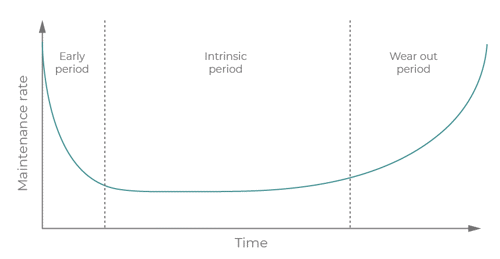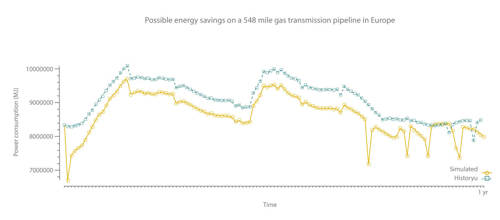The changing landscape of gas pipeline operations
From heating homes to generating electricity and manufacturing materials, natural gas is an energy source that’s been commercially relied on for over 200 years.1 While pipelines remain the safest means of transporting gases, sustaining gas pipeline operations has presented an increasing number of challenges in recent years.
However, the availability of cloud computing has made it feasible to run complex pipeline simulations quickly, which has allowed machine learning (ML) to be introduced to gas transmission and distribution networks.
In the following blog, our Business Development Director for Atmos Intelligent Optimizer (AIO) Bob Truman discusses the following challenges facing gas pipeline operations and how machine learning can provide opportunities for optimization:
- Addressing the increasing cost of operating gas transmission and distribution systems
- Managing the risks associated with operating gas pipelines
- Facilitating greenhouse gas emission reduction
- Managing aging pipeline infrastructure
- Adapting to changing demand
- Managing the complexity of gas transmission and distribution networks
The increasing cost of operating gas transmission and distribution systems
Due to the increasing complexity and requirements of operating gas transmission and distribution systems, operating costs are significantly increasing on gas pipeline networks as operators go to great lengths to meet all customers’ demands while the need for new technology grows.
To ensure the system operates within safe limits, online pipeline simulation software like Atmos SIM provides a real-time view of a gas pipeline system using flow, pressure and temperature measurements on the pipeline.
Atmos Intelligent Optimizer (AIO) works alongside pipeline simulation software to help reliably meet gas contract requirements of pipeline customers. It reduces costs for gas pipeline operators by informing the control room of the best course of action when it comes to planned and unplanned operating events in gas transmission and distribution networks.
Managing the risks associated with operating gas pipelines
To ensure the safety of personnel, the public and the environment, it’s crucial that gas pipelines work within allowable limits. Failure to do so can result in undesirable consequences.
Natural gas pipeline operators are bound by stringent pressure limits on their pipeline networks which dictate a maximum allowable operating pressure (MAOP) and a lowest allowable operating pressure (LAOP).
It’s common for the MAOP on a modern gas transmission pipeline to be above 100 atmospheres, but there are other factors to consider, such as the fact that gas pipelines are typically operated in an imbalanced condition, rarely if ever reaching a steady state. Equally, it’s often a requirement for gas pipelines to have LAOPs to meet customer requirements and the operational integrity of the pipeline. While there are reasonable margins in MAOPs and LAOPs, AIO makes recommendations to reduce the risk of operating pipelines outside allowable limits which in turn secures safe operations while meeting customer requirements.

Figure 1: An example of proposed flow and pressure set points recommended by AIO
Facilitating greenhouse gas emission reduction
As part of the industry’s greenhouse gas emission reduction initiatives, companies are seeking creative, cost effective solutions. With pipeline operations, one low cost way to reduce all emissions is by improving efficiency and reducing energy consumption.
Another solution for reducing greenhouse gas emissions is the introduction of hydrogen into the gas stream. Hydrogen does not generate greenhouse gas emissions when burned but it comes with additional challenges due to its lower energy density than natural gas and hydrogen embrittlement. Operators will have to account for these differences in the way they operate their pipeline systems.
Pipeline simulation software will assist operators in quickly modeling the behavior of the various hydrogen mix, managing the network capacity as well as tracking the gas quality throughout the pipeline system.
While managing greater flexibility in customer supply and delivery, gas pipeline networks are expected to maximize capacity. This creates a challenge during the introduction of hydrogen and hydrogen blends because the maximum capacity is reduced as hydrogen concentrations increase in a natural gas network.

Figure 2: Hydrogen blend maximum capacity calculated by Atmos SIM (Red 0%, green 10%, blue 25% and orange 50%) in an example pipeline network
On operational gas pipelines, AIO can be used to optimize the usage of pipeline capacity as different amounts of hydrogen are introduced. It produces an operational plan including the setpoints for flow and pressure at all controllers.
The simulation software can also be used to detect and locate pipeline leaks to minimize the gas release, thus reducing greenhouse gas emissions.
Managing aging pipeline infrastructure
As with a pipeline transporting any fluid, gas pipelines will inevitably reach their wear out period, a point in a pipeline’s lifecycle where it can be regarded as “aging”. Gas pipelines reaching this point are typically characterized by an increase in pipeline incidents, such as leaks and ruptures, and commonly show more severe signs of corrosion.2

Figure 3: A visualization of the bathtub curve, as used to define the reliability of a product
Atmos Intelligent Optimizer can help reduce the operational volatility so there’s less strain on an aging pipeline’s infrastructure. Its automatic generation of an optimal and actionable operational plan each day creates set points for flow, pressure and equipment, ensuring the smartest use of a gas pipeline network and creating less risk of accelerating pipeline aging.
Adapting to changing demand
Today’s gas pipeline networks can be thousands of miles in length with many delivery points. The demand on the pipeline is always changing and pipeline shippers are insisting on more intraday nomination and volume flexibility. There can be differences between scheduled and actual hourly demand flows as well. It is the pipeline operator’s responsibility to make operational changes for frequent demand variations, all while operating as efficiently as possible.
AIO is essentially an expert in the control room, ensuring a gas pipeline operator has all the information to meet the changing demand and manage the flow, pressure and composition of the gas mix under varying operating conditions.
Complexity of gas transmission and distribution networks
Gas networks are complex with many components, constraints and demands, making it difficult for even the most experienced pipeline operator to know what the best course of action is when multiple changes occur on the system. For example, there could be a change in the forecasted power generation load for the upcoming afternoon while several compressors that are normally used to serve the load are offline. There could be several solutions available, but which solution is the best?
For a complex network with multiple compressor stations and many delivery points, AIO enables gas pipeline operators to benefit from an optimal plan together with a detailed pressure profile for each section of the pipeline network. For example, Figure 4 represents a 548 mile gas transmission pipeline across three countries in Europe where an energy saving of 5% is achievable, saving US$ 5 million at US$56 per MWh per year.

Figure 4: AIO calculated compressor power consumption (yellow) compared with historical data (green)
Machine learning is the future of optimal gas pipeline operations
While there exist a range of challenges in a gas pipeline operation, the machine learning with simulation software solutions like AIO will be what enables gas pipeline operators to minimize energy costs while meeting all customers’ demands, or maximize sales of gas and avoid violating operational constraints.
References
1 https://www.apga.org/apgamainsite/aboutus/facts/history-of-natural-gas
